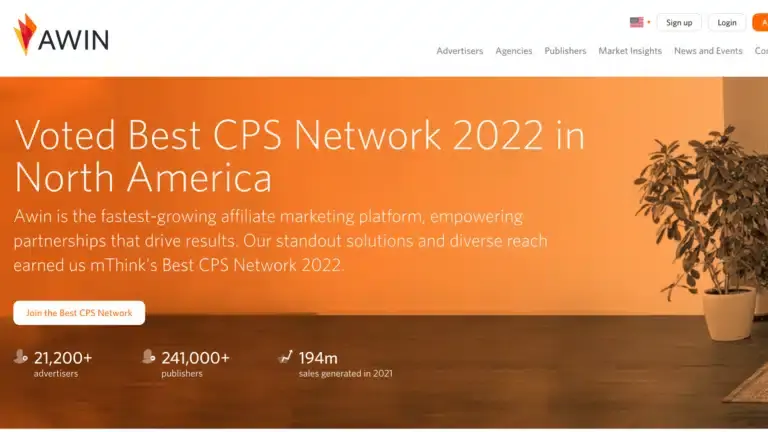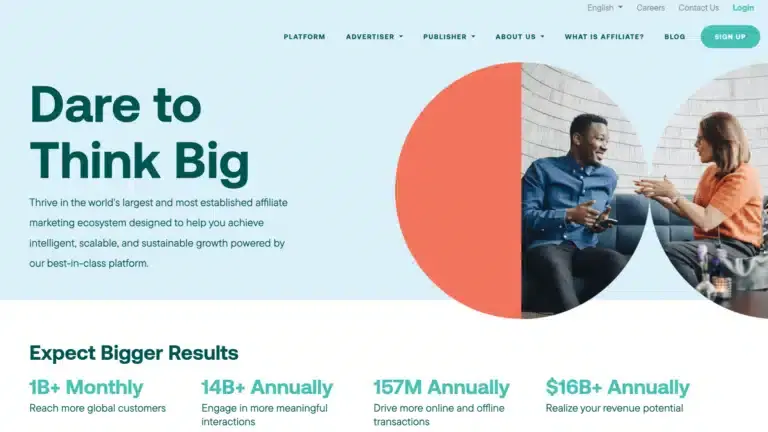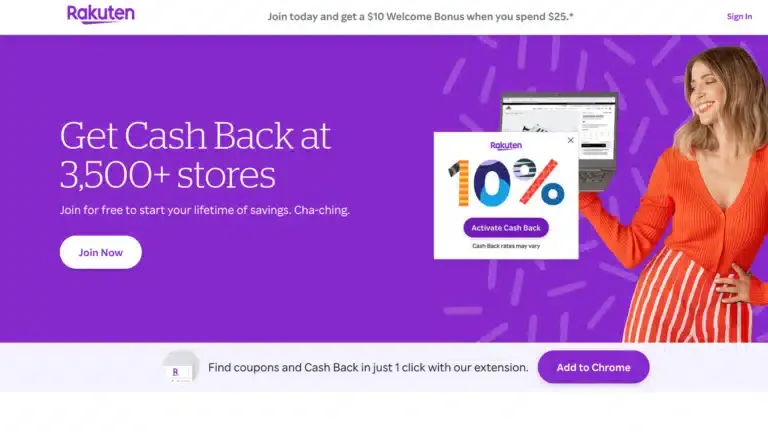Table of Contents
- What is an Affiliate Network?
- Who is in an Affiliate Network?
- When to Use an Affiliate Network
- Affiliate Networks vs. Affiliate Programs
- How an Affiliate Program Works
- Types of Affiliates
- Popular Affiliate Marketing Platforms
- Should Your Business Work With Affiliates?
- Payment Methods for Affiliates
- Ways to Pay Affiliates
- How to Pay Affiliates
- Leveling Up with Affiliate Automation Software
- Importance of Affiliate Marketing
- How Tipalti Scales Global Affiliate Payments
In a sea of marketing noise, you have to cast a wide net. This means you might need a little help. A large number of brands are turning to affiliate marketing to differentiate their content and drive revenue. It’s emerging as a key solution to engage consumers with new products/services, meet heightened user expectations, and produce relevant content with a purpose.
In fact, this avenue of marketing has become so popular that spending in the United States alone has reached a whopping $8.2 billion, up from $5.4 billion in 2017. The market is growing exponentially, with affiliates representing the most popular form of referral marketing we’ve seen in years.
Simply put, affiliate marketing is an advertising model in which a company compensates a third party to generate traffic or leads to sell product/services. These third-party publishers are known as affiliates, and they earn a fixed commission which is typically paid when a sale is made, or another qualified action takes place. The idea is based on a revenue-sharing business model and can lead to multiple companies forming what’s known as an affiliate network.
What is an Affiliate Network?
An affiliate network acts as a middleman between affiliates (publishers) and merchants so they can find each other easier. It can also represent a group of affiliated companies that offer compatible and complementary products/services and will often pass leads back and forth. An affiliate network helps a business open up new sales channels and build a database of potential leads. However, they may not always operate in the same industry.
Who is in an Affiliate Network?

In an affiliate network, there are three parties involved:
#1) The Seller
This could be a corporate enterprise like Reebok, a smaller business, or even an entrepreneur. These people create products, like consumer goods, digital products, and services, then list them through an affiliate network.
#2) The Affiliate
This individual is sometimes called the “publisher” and is responsible for promoting products and engaging potential customers. Affiliates typically have a large target market they cater to, and will receive one-time or recurring commissions for every sale.
#3) The Customer
This is the most important person in the relationship. When they purchase a product/service through an affiliate both the seller and the affiliate score a profit.
When to Use an Affiliate Network
Some affiliate networks offer cross-promotional deals, encouraging their clients to look into services or products offered by an affiliate. A business looking to acquire new customers will often pay members of an affiliate network for sales leads.
Companies also use affiliate networks when they:
- Have a small marketing or advertising budget
- Want to reach a new audience
- Don’t have enough support for outbound sales
An affiliate network is also used when a business wants to grow rapidly and needs an extra hand with advertising.
Affiliate Networks vs. Affiliate Programs
Affiliate networks help publishers find programs and organize affiliate commission payouts. They streamline the process of working with affiliates and influencers, but are different than an affiliate program itself.
The difference between affiliate networks and affiliate programs is that a program typically relates to a single brand, whereas a network can involve thousands of programs that creators can discover and join.
Some affiliate programs may look like networks at first, like the Amazon Affiliate Program or the eBay Partner Network, but the relationship is only with the marketplace, and not the sellers. This is a wonderful place for a new affiliate to start, but differs greatly from an entire network.
An affiliate network, on the other hand, has affiliates working directly with a seller on a dedicated website or landing page. They are assigned a unique ID to track sales, so the brand knows what to attribute to their marketing efforts.
How an Affiliate Program Works

Affiliate networks are easy to use, especially if you have affiliate marketing software. Users simply sign up for the network, then receive access to a number of products on the market. Some networks have strict requirements for an affiliate to join and will deny people access for a variety of reasons.
Affiliate online marketing works by spreading out the responsibilities of product marketing and content creation across multiple parties. It leverages the abilities of different talents for a more effective strategy, while providing all contributors with a share of the profit. For some people, it’s passive income, and in other cases, marketers make a full-time living.
An affiliate program works using the following steps:
Step #1 – The affiliate posts an ad or a link for a product/service on a website, blog, or social media channel.
Step #2 – A customer comes to the site and clicks the unique tracking link.
Step #3 – The customer is redirected to the online store for the product/service.
Step #4 – They then make a purchase on that site.
Step #5 – The affiliate network records the purchase and any other transaction details.
Step #6 – The transaction is credited to the affiliate.
Step #7 – Commission is then paid to the affiliate marketer.
Types of Affiliates
Proper affiliate marketing management requires a brand to have a deeper understanding of how affiliate networks operate, and the types of networks you can work with. The larger the affiliate platform, the harder it will be to manage.
The three main types of affiliate marketing networks are:
Unattached Affiliate
In this advertising model, the affiliate has no connection to the product/service they promote. They have no known related expertise or skills, and do not serve as an authority or make claims on its use. This type of affiliate marketing is the most uninvolved and the lack of engagement with the potential customer absolves them from the duty to advise or recommend.
Related Affiliate
Related affiliate networks involve promotion from an affiliate with some type of relationship to the offering. The connection is generally between the influencer’s niche and the product/service. They have enough expertise and influence to generate organic traffic, and their level of authority drives awareness and trust. However, in this case, the affiliate makes no claims about the product or service.
Involved Affiliate
This type of marketing establishes a deeper connection between the affiliate and the product/service they’re promoting. The advocate has used or currently uses the product or service they are marketing, and is confident in relaying a positive experience to others. Their actual experiences work as advertisements and they are trusted sources of information for their audience.
Popular Affiliate Marketing Platforms
Although people may immediately think of Amazon or eBay when they ponder affiliate networks, those companies are more like marketing programs. A recent report has shown, that the top affiliate networks are actually AWIN, which has 30% of publisher links worldwide, followed by CJ affiliates with 15.8%, and Rakuten with 7.4%.
AWIN

AWIN is one of the best affiliate networks because they operate in over 180 countries with 16,500+ advertisers and 200,000+ active publishers. They were also voted the best CPS (cost per sale) network in all of the United States.
The service is an excellent choice for beginners and offers a variety of business verticals like fashion, travel, and technology. Cookies last 30 days and the commission rate is approximately 5%.
Affiliates can sign up with a $5 deposit, which they can get back after the first payment threshold. The brand also owns another popular affiliate platform called ShareASale.
CJ Affiliate

Formerly known as Commission Junction, the newly rebranded CJ Affiliate was founded in Santa Barbara, CA in 1998. The company is trusted by twice as many IR500 brands as its nearest competition.
CJ Affiliate is a SaaS that’s easy to join, with seven simple steps, including adding promotional property (like social media accounts) if you’re an affiliate. The platform is best for advanced affiliates and developers, due to the open developer portal and API access.
Rakuten

Another big name that breeds successful affiliates is Rakuten. Formerly known as LinkShare, the affiliate network is smaller with about 1,000 merchants. However, the company focuses on high quality over quantity. They work with some of the largest names in a variety of industries. Some of their well-known clients include:
- Microsoft
- Sephora
- Virgin Holidays
- New Balance
- Udemy
Rakuten also helps small companies benefit from a big-name brand reputation.
Should Your Business Work with Affiliates?
Before you set out on any new business venture, it’s critical to weigh the pros and cons. Although affiliate networks are generally a positive approach to marketing, there are also some setbacks you should be aware of. Here are the benefits and pitfalls of signing up for this type of marketing:
Benefits of an Affiliate Network
When done correctly, affiliate marketing can yield great rewards for the advertising company and the affiliate marketer. The business benefits from low-cost advertising and creative marketing efforts, and the affiliate benefits by earning high commissions and incentives.
The best affiliate programs have a big return on investment (ROI) as the company is only paying for traffic that is converted to sales. The cost of advertising itself, is borne by the affiliate alone since the payment method is usually based on performance.
Additional pros to an affiliate network include:
- Access to a bigger audience and a broader market
- Better accounting of leads that are qualified
- Drive incremental sales with little to no risk
- Free exposure by bloggers on different types of publishers or content sites
In addition to increasing customer reach, revenue, and traffic, affiliates also help to build brand awareness and drive loyalty.
Does your business rely on the digital economy?
Brands should leave nothing to chance when it comes to paying partners.
Disadvantages of an Affiliate Marketing Network
The advertising company is the one that sets the terms for the affiliate marketing program, and early on, brands largely paid the cost per mile (impressions) and the cost per click (traffic) on banner ads. As technology has evolved, the focus turned to commission on real-time sales and qualified leads. However, early affiliate marketing programs were vulnerable to fraud in a lot of ways, and the case still remains for some affiliate programs.
Common fraud techniques used in affiliate networks include (but are certainly not limited to):
Click Fraud
This is when fraudulent clicks are made on an advertiser’s banner ads or paid text links. The intention is to falsely drive up the number of payable clicks, resulting in a higher affiliate payout.
Cookie Stuffing
Cookie stuffing is when an affiliate forces cookies onto a customer without any prompted action on the customer’s side. A publisher can utilize a single-pixel iframe to force a cookie onto a customer as soon as they visit the site. The cookie duration has nothing to do with anything the user can accomplish on the page.
Typosquatting
This is when a fraudulent affiliate capitalizes on the misspelling of a popular brand name. This happens when the web URL for a popular company is misspelled, the fraudster will have that redirect to the actual site, using an affiliate link. These people will squat on a domain name that is misspelled and then collect commission for the redirect.
Purchase AdWords and Adware
Unscrupulous affiliates can populate online forms with fake or stolen data. They will purchase AdWords on specific search terms a company already ranks high on to mess with the SEO. Installing spyware or adware will also redirect search queries for a product, straight to an affiliate’s page.
Additional disadvantages to an affiliate network include:
- Less control over creatives and exposure
- Affiliate links can compete with other ads from different channels
- These types of marketing programs require strong oversight and management (dedicated affiliate manager)
- Need to develop a model to ensure you’re not overpaying for certain types of sales
The majority of today’s affiliate networks have strict terms and conditions on how affiliates generate leads. Some programs go so far as delineate how a product/service is discussed in the content, before the affiliate link can be validated.
Payment Methods for Affiliate Networks
Affiliate networks are typically free for the publisher to participate in, but they will carry a cost for merchants. The common affiliate network has an initiation fee, and a monthly subscription charge for tools and services. They may also take a small share of transactions made on an affiliate site.
There are two main models of payment for affiliate offers:
Revenue Share or Revshare
This payment method is where publishers take a specific percentage of the merchant’s revenue as a charge for sharing the ad on their channels. The standard affiliate commission can range from 1% to 75%, or even 90% on some platforms.
Cost Per Action (CPA)
In this payment model, publishers get paid for every visitor that completes a pre-specified set of actions on the merchant’s website. For example, registering for a mailing list, participating in a survey, or purchasing a product/service.
Power your entire partner payouts operations
98%
Customer Satisfaction
$60B+
Annual Transactions
4M+
Partners
5,000+
Customers
99%
Customer Retention
Ways to Pay Affiliates
Once you have decided on the revenue-sharing method for your affiliate network, it’s time to decide on the payment type. Since affiliates can work remotely, from anywhere in the world, they typically accept a variety of payments, including:
- Wire transfers
- PayPal or Payoneer
- Direct deposit
- ACH transfer
- eCheck
- And more…
How Do You Pay Affiliates?

In order for an affiliate to get paid, the consumer doesn’t necessarily need to buy a product. Depending on the affiliate network and brand, the affiliate’s contribution to sales will be measured differently. Thus, there are a few different types of affiliate payments and ways you can pay a freelance marketer. This includes:
Pay-Per-Click
Bloggers and high-traffic websites use the pay-per-click (PPC) model. It requires that the reader click on links that redirect to a brand’s page, paying a few cents every time this happens. No sales need to be made, you are simply paying for traffic that hopefully leads to new customers.
Cost-per-click (CPC) programs focus on incentivizing the affiliate to send the customer from their site to yours. This means they must engage the consumer to the extent they will keep clicking through to the brand’s site. In pay-per-click, there are two common concepts:
- EPC (earnings-per-click) – This is the measurement of the average earnings for every 100 clicks for all affiliates in a program.
- CPA (cost-per-acquisition) – The affiliate gets paid each time the brand acquires a new lead. This can happen when an affiliate directs the customer to the merchant’s website and they take action, such as subscribing to a newsletter or filling out a “Contact Us” form.
Pay-Per-Action
There are many different ways to pay an affiliate based on the action a lead takes. In this cost-per-lead (CPL) model, the potential customer must click on the affiliate link, and then follow some type of call-to-action on the brand’s page. This can include:
- Pay-per-call – the lead makes an appointment or schedules a call
- Pay-per-install – the potential customer installs a product (like a mobile app)
- Pay-per-registration – the user signs up or registers for a newsletter or email list
In the end, more money can be made by this method for those affiliates willing to partake in pay-per-action. When a purchase is made, your affiliate partner will receive higher compensation. If residuals are included in the contract, then the referrer also receives commissions on future sales from the new referral.
The most popular way to do this is through leads and sales, but, as you can see above, it can be anything that drives a consumer further down the sales funnel.
Pay-Per-Impression
This is also referred to as “pay-per-view” and really equates to paying an affiliate every time the advertisement is displayed on their website. Prices are generally set per one thousand page impressions.
Two-Tier Affiliate Programs
In this payment model, the affiliate marketer controls the entire underlying affiliate network. They receive commission on their referrals and those from the network. This type of program also allows for multi-level marketing.
Companies can use a combination of affiliate program types. For example, Amazon Associates uses both pay-per-action and pay-per-click leads and sales in its associate program affiliate marketing program.
Leveling Up with Affiliate Automation Software
One of the best ways to track the performance of your affiliate marketing program, from conversion rates to engagement, is through a reporting tool known as affiliate software. The most popular form of affiliate technology, it’s a means to measure the efforts of all parties involved and determine if the strategies are cost-effective.
The user-friendly software is a marketing platform that helps to credit referrers based on metrics like clicks, impressions, and page views. It tracks the referral, endorsement, or recommendation made by an individual or company to buy products/services from another party. The tracking refers to:
- Browser detection
- User-client IP detection
- Marketer’s affiliate referral
- Advertiser’s completed transaction
Affiliate software can be hosted remotely or installed on a local server. A brand can set up a panel of affiliates and give them access to create their own platforms.
Additional features for affiliate software are:
- Tracking sales and leads
- Writing program rules and policies
- Adding physical products and creatives
- WordPress plug-in integration
- Managing affiliate sales and payments
This type of software should also enable a brand to communicate with affiliates and offer robust customer support.
The cost for affiliate software can range from a monthly subscription fee of $30 to $300. Don’t rush into any purchasing decision. Many of these programs offer a basic program with simple affiliate payout methods.
Importance of Affiliate Marketing
Recent studies show that 81% of brands rely on affiliate links because they involve very little investment. Affiliate networks are one of the most affordable and risk-averse options for ecommerce companies, small businesses, and enterprises alike. It enables brands to effectively market a product or service with a low budget, little time, and practically zero effort. Organizations are able to accomplish this at a well-contained risk level, while guaranteeing a high return on investment, greater brand awareness, and increased business growth.
Affiliate networks can be seen as expanding your marketing team by employing the services of a third party, which are only paid when leads are converted and successful sales are made. Networks have a myriad of advantages that brands are beginning to exploit.
It’s no surprise, this method of digital marketing is gaining more traction than popular forms like email and SMS campaigns. It’s only a matter of time before affiliate marketing becomes the best way to reach potential customers and explore new markets.
This is why it’s crucial that you prioritize the satisfaction of your affiliates. Offer best-in-class partner experiences and make sure that payments are the top perk. Read more about it in our free ebook: Why Payments Are Critical to Creators and Influencers.
How Tipalti Scales Global Affiliate Payments
With Tipalti, affiliate networks and ad networks will never need to implement another system to handle payments, spend valuable time managing payables, or hire resources to keep supporting accounts payable. Tipalti ensures that publishers and partners have a high level of satisfaction with their commission and payouts. Over 2,000 customers rely on Tipalti’s best-reviewed global payables automation platform for modern, high-velocity affiliate marketing.

